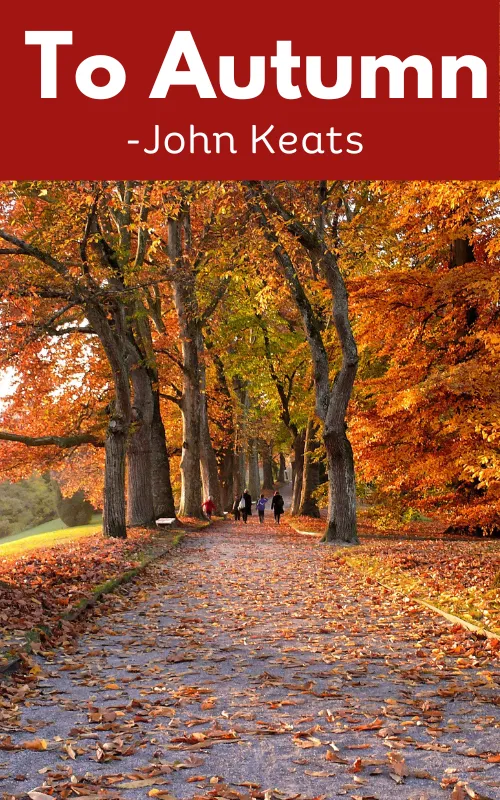About the Poem “To Autumn“
| Poem Title | To Autumn |
| Poet | John Keats |
| Year Published | 1820 |
| Form | Ode |
| Meter | Iambic pentameter |
| Theme | The beauty and transience of the autumn season |
| Rhyme Scheme | ABABCDEDCCE (Stanza 1), ABABCDECDDE (Stanzas 2 and 3) |
| Imagery | Harvest, nature, animals |
| Tone | Serene and contemplative |
| Structure | 3 stanzas of eleven lines each |
| Literary Devices | Imagery, personification, alliteration |
Themes of To Autumn
The themes of poem “To Autumn” by John Keats are:
- Nature’s Bounty ➤ The poem celebrates the richness of the harvest season, with vivid descriptions of fruits and crops.
- Transience of Life ➤ It reflects on the fleeting nature of life and the inevitable arrival of winter, drawing a parallel between the season’s decline and human mortality.
- Artistic Inspiration ➤ Keats finds inspiration in the natural world, using it as a metaphor for the poetic process and the beauty of art.
- Cycles of Nature ➤ The poem emphasizes the cyclical and rhythmic patterns of nature, with autumn being a vital part of this ongoing cycle.
“To Autumn” Poem by John Keats
Season of mists and mellow fruitfulness,
Close bosom-friend of the maturing sun;
Conspiring with him how to load and bless
With fruit the vines that round the thatch-eves run;
To bend with apples the moss’d cottage-trees,
And fill all fruit with ripeness to the core;
To swell the gourd, and plump the hazel shells
With a sweet kernel; to set budding more,
And still more, later flowers for the bees,
Until they think warm days will never cease,
For summer has o’er-brimm’d their clammy cells.
Who hath not seen thee oft amid thy store?
Sometimes whoever seeks abroad may find
Thee sitting careless on a granary floor,
Thy hair soft-lifted by the winnowing wind;
Or on a half-reap’d furrow sound asleep,
Drows’d with the fume of poppies, while thy hook
Spares the next swath and all its twined flowers:
And sometimes like a gleaner thou dost keep
Steady thy laden head across a brook;
Or by a cyder-press, with patient look,
Thou watchest the last oozings hours by hours.
Where are the songs of spring? Ay, Where are they?
Think not of them, thou hast thy music too,-
While barred clouds bloom the soft-dying day,
And touch the stubble-plains with rosy hue;
Then in a wailful choir the small gnats mourn
Among the river sallows, borne aloft
Or sinking as the light wind lives or dies;
And full-grown lambs loud bleat from hilly bourn;
Hedge-crickets sing; and now with treble soft
The red-breast whistles from a garden-croft;
And gathering swallows twitter in the skies.
To Autumn Summary & Analysis
Stanza 1
The poem opens with the speaker addressing Autumn directly, personifying it as a goddess or other divine figure. The speaker praises Autumn’s beauty and abundance, noting the “conspiring” way that it works with the sun to ripen the fruits of the harvest. The speaker also describes the various fruits and vegetables that are in season during autumn, such as grapes, apples, gourds, and hazelnuts.
Stanza 2
The second stanza of the poem shifts its focus to the activities of the harvest. The speaker describes Autumn as a “thresher” sitting on a granary floor, a “reaper” asleep in a grain field, a “gleaner” crossing a brook, and a “cidre-maker’s jug” swelling with the juice of apples. These images evoke the hard work and dedication that goes into harvesting the fruits of the earth, as well as the sense of community and celebration that often accompanies this time of year.
Stanza 3
The final stanza of the poem returns to the speaker’s praise of Autumn’s beauty and abundance. The speaker compares Autumn’s music to the songs of spring, noting that while the two seasons are different, they are both equally beautiful. The speaker also describes the various animals that are active during autumn, such as crickets, robins, and swallows. These images evoke the sense of vibrant life that still exists in the natural world, even as the days grow shorter and the air turns cooler.
FAQs from To Autumn
What is the poem about?
The poem is about the beauty and abundance of the autumn season. Keats uses vivid imagery and sensory details to create a rich and immersive experience for the reader.
What are some of the fruits and vegetables that Keats mentions in the poem?
The fruits mentioned in the poem are: Keats mentions grapes, apples, gourds, hazelnuts, and grain.
What are some of the activities that Keats describes in the poem?
Keats describes threshing, reaping, gleaning, and cider making.
How does Keats personify autumn in the poem?
Keats personifies autumn as a goddess or other divine figure. He also describes autumn as a “thresher,” “reaper,” “gleaner,” and “cidre-maker.”
What does autumn symbolize in the poem To Autumn?
Autumn symbolizes the beauty and abundance of the harvest, as well as the cycle of life and death.











